Are you a Quiet Speculation member?
If not, now is a perfect time to join up! Our powerful tools, breaking-news analysis, and exclusive Discord channel will make sure you stay up to date and ahead of the curve.
Modern is vast and diverse enough to make metagaming a frequently terrible idea. However, sometimes it is warranted. With Izzet Phoenix, followed by Dredge, consistently dominating the big tournaments in a way that Modern hasn't seen in years, it makes sense for the first time in a long time to actively target the top decks. How to do that is the question.
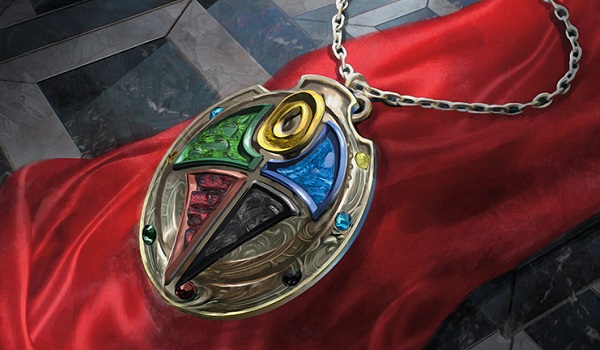
Much of the reaction so far has been maindecking Surgical Extraction, which given the tournament results, doesn't appear to be working. I've suggested attacking Phoenix's velocity engine, but that hasn't been widely adopted and doesn't work against Dredge. The search is still on, and today I'll discuss how successful decks are adapting to a Phoenix-filled metagame.
While looking over the GP weekend's decklists, I was both disappointed and hopeful. The disappointment came from a lack of dramatic change from Regionals. Given the available data, I expected players to have caught onto the threat of Phoenix, even if the result was an outlier at the time, and planned ahead. However, there hadn't been any grand changes yet. Instead, I saw incremental adjustments and tweaks. That was less than I hoped for, but still signaled that players were adjusting, and could soon reign in the firebird.
Between a Rock...
First up is the runner-up from Philadelphia. BGx has been struggling for the past year. It's never been bad, but between Dredge returning, hexproof Spirits rising, and then Arclight Phoenix's ascension, Fatal Push has been having a very hard time. BGx and particularly Jund are the best decks around at 1-for-1 trading, but decks have gotten too good at breaking those trades via recursive threats. This is unfortunate because Phoenix decks are vulnerable to being grinded out of threats if they can't swamp opponents. However, Jonathan Orr may have cracked the code.
The Rock, Jonathan Orr (2nd, SCG Philadelphia Open)
In a world full of graveyard decks, this is the sideboard I want to see. Orr has multiple one-shot effects to pair with his maindeck hate and Grafdigger's Cage. One-shot effects are great at slowing down graveyard decks, but they're easy to play around. This is especially true if they hit the board and then sit there, like Nihil Spellbomb. It's also critical to pack extra against Dredge, which can quickly 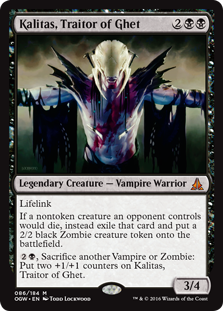 recover from a single graveyard purge; it's the second one that actually hurts. And again, that frequent refrain, Surgical Extraction is not Dredge hate. It's fine against Phoenix, but only mediocre against Dredge's multiple targets and threats.
recover from a single graveyard purge; it's the second one that actually hurts. And again, that frequent refrain, Surgical Extraction is not Dredge hate. It's fine against Phoenix, but only mediocre against Dredge's multiple targets and threats.
However, the real advantage of Orr's list is more subtle. For some time, Rock lists have been running Kalitas as both incidental hate and a value engine. In a metgame full of recursive threats, the Vampire is also key to making removal matter. Without Kalitas, Push is a card-disadvantageous speed bump. This means that the re-adoption of Maelstrom Pulse is a brilliant decision. Assassin's Trophy largely pushed out Pulse and Abrupt Decay, but having a way to remove multiple Arclight Phoenixes or Prized Amalgams with one card, especially around Scavenging Ooze or Kalitas, is invaluable and critical for Rock to catch back up. I imagine that more Rock players will catch on and play more Pulses in the foreseeable future.
...and a Hard Place
A rising option is to simply shut down Phoenix. The deck is very one-dimensional, and is really just a cantrip deck. I've advocated attacking the velocity engine with Eidolon of Rhetoric, but some are taking the more direct approach. Rather than adjust their decks for a Phoenix world, they're grabbing one that negates each of Phoenix's plans cold.
Whir Prison, Louis-Samuel Deltour (2nd, GP Bilbao)
It doesn't matter how many spells are cast if they don't resolve. Chalice of the Void is back and in force.
I've slagged off plenty of decks for being primarily air or dependent on single cards to work, but is all the above and more. Whir Prison is a deck built entirely around Ensnaring Bridge. Chalice of the Void is important too, but it's not the critical piece. The deck will not beat any creature deck 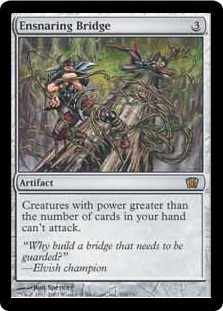 without Bridge. Everything either finds, protects Bridge, or is easy to dump from hand to enable Bridge and do nothing otherwise. This prison is far faster to build than any other we've seen, but it's also far more fragile. It's very much a deck built on the assumption that it only has to face certain decks, because it's not going to beat anything outside its narrow attack spectrum.
without Bridge. Everything either finds, protects Bridge, or is easy to dump from hand to enable Bridge and do nothing otherwise. This prison is far faster to build than any other we've seen, but it's also far more fragile. It's very much a deck built on the assumption that it only has to face certain decks, because it's not going to beat anything outside its narrow attack spectrum.
Some Whir of Invention decks also run the Thopter Foundry/Sword of the Meek combo, but the Top 8 lists consistently stick to looping either Ipnu Rivulet or Pyrite Spellbomb. This initially struck me as odd considering all the graveyard hate running around. But they do play Tezzeret, Agent of Bolas and Sai, Master Thopterist out of the sideboard to compensate. With a game locked up, it's only a matter of time before those alternate win conditions are found.
Alternatively, Amulet...
Whir is the new kid on the block, as far as fighting Phoenix goes. The real success stories have been from big mana decks. Other decks have had decent results, but Amulet Titan, Mono-Green Tron, and to a lesser extent Valakut, the Molten Pinnacle decks have consistently inhabited the Phoenix-heavy Top 8's of the past few months. It makes sense since they're not affected by the types of hate targeted at Phoenix or Dredge and can either ignore their gameplan or organically clean it up. In fact, current Tron lists don't look dramatically different from what was winning last year. On the other hand, the Amulet lists have made subtle but important changes.
Amulet Titan, Matthew Dilks (4th, SCG Philadelphia Open)
The first thing to note is the increased Forest count. Justin Cohen only ran one when he brought the deck to the world, and last year, most ran only two. Amulet decks have always been vulnerable to Blood Moon, to the point that Cohen didn't think he could ever beat it even with significant sideboard space. However, the increasing popularity of Field of Ruin has led to Amulet hedging against getting Strip Mined. This has the added benefit of reducing the vulnerability to getting Mooned, though it doesn't eliminate it.
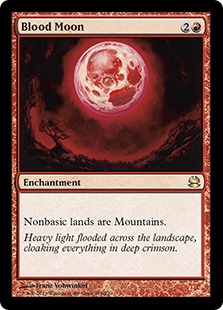 However, in a world where the most popular deck by far can and frequently does run Blood Moon, a few more Forests isn't enough. Instead, Titan has started running former Standard staple Coalition Relic. Back in Time Spiral Block Constructed, Relic was a critical piece of Mystical Teachings Control decks, serving as a combination of fixing and acceleration. In Standard it competed with Coldsteel Heart, which was cheaper but also couldn't provide the extra burst of mana Relic did.
However, in a world where the most popular deck by far can and frequently does run Blood Moon, a few more Forests isn't enough. Instead, Titan has started running former Standard staple Coalition Relic. Back in Time Spiral Block Constructed, Relic was a critical piece of Mystical Teachings Control decks, serving as a combination of fixing and acceleration. In Standard it competed with Coldsteel Heart, which was cheaper but also couldn't provide the extra burst of mana Relic did.
In Modern Titan decks, Relic functions like an additional Azuza, Lost but Seeking. However, against Phoenix, it allows for Primeval Titan to be cast the following turn even under Blood Moon. Even when there is no Moon, extra mana is critical for Amulet to actually keep up with Phoenix. Relic also facilitates the sideboard plan of slamming green creatures and Path to Exile. Considering that artifact removal is usually ineffective against Amulet decks due to their speed, Relic is an incredibly intelligent addition.
...Or, Kill 'Em All
Finally, I return to another old refrain: control should be doing better than it is. There's a clear metagame trend for graveyard decks, and answer decks should be adjusting their disruption accordingly. However, after some positive signs from Regionals control players, I was very disappointed by their showing at the GP's. It was just too hard for some to catch up in time. It turns out I may have been looking in the wrong place, and that work was being done in the smaller tournaments.
Jeskai Control, Jonathan Sukenik (5th, SCG Philadelphia Classic)
The first item of note is only one Lightning Bolt. How the mighty have fallen. In a world of Dredge and Phoenixes, Bolt just isn't good enough anymore, a huge turnaround from last year. Instead, Johnathan Sukenik has fully embraced recovering from swaths of recursive 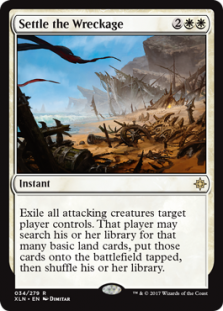 creatures. He is running full sets of both Lightning Helix and Cryptic Command, perfect for regaining lost ground in the early turns. He's also maindecking Settle the Wreckage, though I don't see the value in splitting numbers with Supreme Verdict. Destroying creatures is at an all-time low in value, and while Supreme is more versatile, this isn't the time for extra versatility.
creatures. He is running full sets of both Lightning Helix and Cryptic Command, perfect for regaining lost ground in the early turns. He's also maindecking Settle the Wreckage, though I don't see the value in splitting numbers with Supreme Verdict. Destroying creatures is at an all-time low in value, and while Supreme is more versatile, this isn't the time for extra versatility.
Initially, I was skeptical of the full set of sideboard Surgicals. Doesn't control have better options? Then, I saw the Isochron Scepter, and it made sense. Sukenik intends to effectively mill out Dredge and Phoenix in post-board games. It's very unlikely that either would know to pack artifact removal, so this plan makes some sense. I would expect Dredge to have Assassin's Trophy at least, since Rest in Peace is a card, but it seems to have worked out. I'm mostly impressed that someone found a good use for Scepter again; it's another card that's fallen a long way since its heyday.
Bottom Line
Change is coming in Modern, if coming slowly. The incremental changes that we've observed so far has certainly helped their pilots. However, these minor changes prove that Phoenix is beatable and that Modern can deal with this problem. I look forward to seeing what new developments arrive in the next few weeks.




This is great news. I dont understand why the metagame responded to pheonix so slowly, but I do hope these changes occur quickly. I would prefer not to see a ban by wizards but rather the players adjust. I dont think pheonix is so powerful that I cant be adjusted to.
Hey David, long ago there was a fringe mono white ghostly prison deck that splashed either red, green, or blue. Any thoughts on a return of that old archetype in this creature-centric meta?
I don’t think anything’s actually changed to be honest. Every Modern PPTQ season that deck resurfaced in some form in Colorado, usually WR Sun and Moon. It was great as a surprise deck and occasionally did well but only for one tournament. The problem isn’t the metagame, the deck is just anemic. It may not get hit by hate like artifact prison, but it’s just ends up being worse each season. Much like the Whir Prison deck it just folds to Cryptic Command but it’s worse because it doesn’t have the benefit of all the artifact cantrips to make it consistent. Even with Idyllic Tutor it isn’t able to lock out opponents as consistently and thus just fails more often.
Do you think the rise of the whirr prison deck will be enough for wizards to see the players adjusting and not take action against cards in the pheonix deck?
I doubt it. As I note, it’s a very fragile prison deck. More robust decks like Lantern and previous versions of Whir have had their moments, but they’ve all fallen away over time since they all lose to Shatterstorm. Once the Phoenix players start adjusting to this counterattack, Whir should fade again. Also, given how Wizards doesn’t like prison very much, I doubt one doing well would be seen as a positive to the status quo.
Many lists play now Jester Cap alongside Unmoored Ego. In many cases even if you have a couple of Artifact hate (i.e. shatterstorm) you’ll never be able to cast them. Another option that is adopted is Darksteel Forge. They are actually less fragile than they seem. A good player can achieve MW% greater than 60% against all tier decks (see sussurrus_mtg twitch streams for reference).
That said I agree that it will remain a tier 2 or less deck that can’t be the police deck someone prays for.